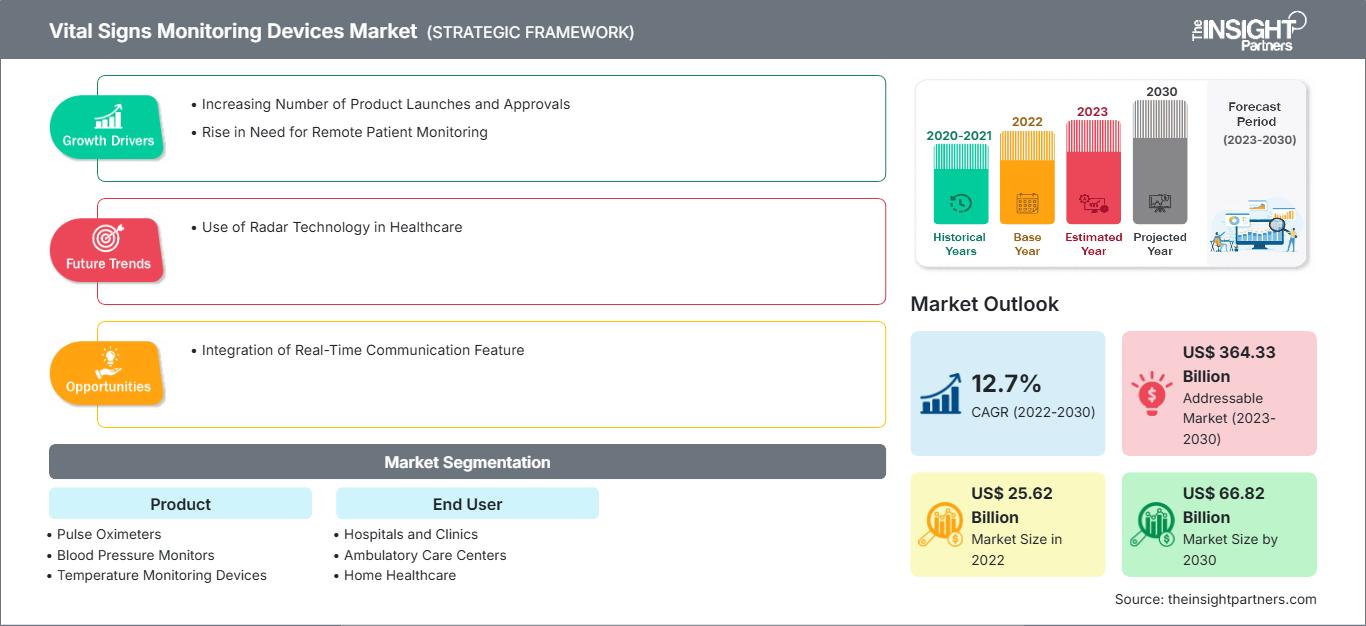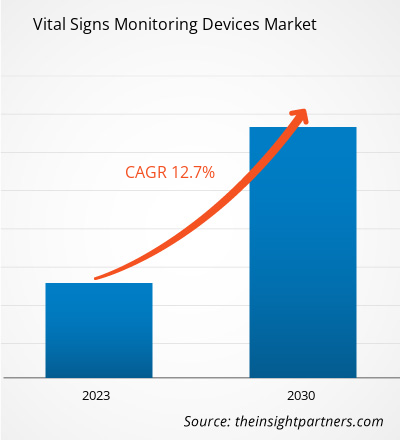[研究报告] 2022 年生命体征监测设备市场规模为 256.1724 亿美元,预计到 2030 年将达到 668.2403 亿美元。预计 2022 年至 2030 年的复合年增长率为 12.7%。
市场洞察和分析师观点:
远程病人监测的日益普及推动了生命体征监测设备市场的增长。在 COVID-19 疫情期间,远程医疗的兴起促进了家庭医疗保健的增长。此外,随着人们越来越意识到使用脉搏血氧仪、体温计和血压监测仪来追踪生命体征作为预防措施,也推动了对这些设备的需求。随着老年人口的增长以及人们对健康生活方式的认识不断提高,人们对家庭医疗保健的偏好激增,这是推动生命体征监测设备市场发展的另一个重要因素。
增长动力与挑战:
在全球生命体征监测设备市场中,各公司正在利用医疗技术的持续进步来设计、开发和升级其现有产品。频繁的产品发布极大地促进了市场增长,因为它鼓励参与者通过开发创新产品和获得产品监管部门的批准来相互竞争。以下列出了一些近期发布和批准的、对市场增长做出重大贡献的产品。
- 2023 年 6 月,Masimo 的 Radius VSM(一款连续多参数生命体征监测仪)获得了美国食品药品监督管理局 (FDA) 的批准。该设备旨在帮助医生测量血压、体温、呼吸频率、心电图和血氧等生理参数。 Radius VSM 集成的 Masimo SET 脉搏血氧仪可监测患者的血氧水平。此外,Masio Radius VSM 是一款自主操作的设备,也可以通过无线方式连接到 Masimo 床边监护仪(包含 Root 和 Masimo 医院自动化平台)使用。
- 2023 年 4 月,霍尼韦尔推出了一款实时健康监测系统,用于在医院和远程机构捕捉患者的生命体征。该系统集成的传感技术通过皮肤贴片监测生命体征,并通过移动设备和在线仪表板即时通知医护人员。通过这项创新,该公司可以帮助改善居家、医院和门诊手术中心的患者护理。
- 2022 年 6 月,GE 医疗宣布推出 Portrait Mobile,这是一款结合了无线患者佩戴传感器和智能手机式监护仪的产品。佩戴这款监测设备的患者可以自由活动,不受任何位置限制。 2023年8月,通用电气医疗集团(GE Healthcare)的Portrait Mobile获得FDA批准,其Carescape Canvas患者监护平台也获得了510(k)批准。
- 2021年4月,Oxehealth Service的生命体征软件获得FDA批准,该软件可以通过连接到设备上的摄像头监测心率和呼吸。该产品适用于疗养院和长期护理机构的最终用户。
- 2020年1月,BioIntelliSense, Inc.宣布其数据即服务(DaaS)平台正式商业化。该公司还宣布其用于远程护理设备的贴体传感器BioSticker获得FDA 510(k)批准。此外,2020年7月,BioIntelliSense, Inc.与荷兰皇家飞利浦公司合作,将BioSticker集成到飞利浦的远程患者监护设备中。
另一方面,近年来生命体征监护设备的召回率有所上升。过去几年,生命体征监测设备市场的一些主要参与者都曾实施过产品召回。监管机构担心产品召回会暴露出参与者的缺陷,并损害其品牌形象。因此,企业和监管机构的产品召回正在阻碍生命体征监测设备市场的增长。
自定义此报告以满足您的要求
您将免费获得任何报告的定制,包括本报告的部分内容,或国家级分析、Excel 数据包,以及为初创企业和大学提供超值优惠和折扣
生命体征监测设备市场: 战略洞察

- 获取本报告的主要市场趋势。这个免费样本将包括数据分析,从市场趋势到估计和预测。
您将免费获得任何报告的定制,包括本报告的部分内容,或国家级分析、Excel 数据包,以及为初创企业和大学提供超值优惠和折扣
生命体征监测设备市场: 战略洞察

- 获取本报告的主要市场趋势。这个免费样本将包括数据分析,从市场趋势到估计和预测。
报告细分和范围:
生命体征监测设备市场根据产品和最终用户进行细分。根据产品,市场细分为脉搏血氧仪、温度监测设备、血压监测仪和血糖监测设备。根据最终用户,市场分为医院和诊所、门诊护理中心、家庭医疗保健等。根据地域,市场分为北美(美国、加拿大和墨西哥)、欧洲(英国、德国、法国、意大利、西班牙和欧洲其他地区)、亚太地区(中国、日本、印度、韩国、澳大利亚和亚太其他地区)、中东和非洲(南非、沙特阿拉伯、阿联酋和中东和非洲其他地区)以及南非和中美洲(巴西、阿根廷以及南美洲和中美洲其他地区)。
分部分析:
基于产品,血糖监测仪细分市场在 2022 年占据了生命体征监测设备市场的最大份额。脉搏血氧仪细分市场预计将在 2022 年至 2030 年期间实现最快的复合年增长率。血糖监测设备用于诊断糖尿病患者的高血糖和低血糖状况。这些设备使患者和临床医生能够检测高血糖或低血糖水平,从而进一步调整治疗方案,并通过及时确认急性低血糖或高血糖来保护患者。该技术有助于患者了解糖尿病及其管理。
脉搏血氧仪是一种用于测定红细胞携氧饱和度的电子设备。脉搏血氧仪市场的增长主要得益于心血管疾病和呼吸系统疾病患病率的上升、微创手术需求的增加以及这些设备的最新发展。脉搏血氧仪有台式和手持式两种型号,并配有配件。
根据最终用户,市场可分为医院和诊所、门诊护理中心、家庭医疗保健和其他。医院和诊所在2022年占据了最大的市场份额。预计家庭医疗保健将在2022年至2030年期间实现最快的复合年增长率。医院和诊所数量的增加、对家庭医疗保健环境的偏好激增以及医疗器械研发的不断增加是推动生命体征监测设备市场增长的关键因素。
区域分析:
根据地域划分,
生命体征监测设备市场分为北美、欧洲、亚太地区、中东和非洲以及南美和中美。北美是市场增长的最大贡献者,预计欧洲在 2022 年至 2030 年期间的复合年增长率最快。北美市场的增长归因于呼吸系统疾病的广泛增加、大量的糖尿病患者以及民众对呼吸系统疾病认识的提高。在欧洲,生命体征监测设备市场受到慢性病发病率上升、产品上市数量增加、产品开发投资增加以及老龄化人口激增等因素的推动。
行业发展和未来机遇:
以下列出了生命体征监测设备市场主要参与者的各种举措:
- 2023 年 8 月,通用电气医疗集团 (GE HealthCare) 推出了智能手机大小的 Portrait Mobile,使用支持无线协议的可穿戴传感器持续监测患者的生命体征。该设备不需要患者一直躺在病床上进行生命体征监测。Portrait Mobile 采用创新的测量技术,可以持续、准确、可靠地捕捉呼吸频率,而呼吸频率是患者早期病情恶化最敏感的生命体征之一。
- 2023 年 5 月,总部位于日本的电气设备公司欧姆龙 (Omron) 宣布计划在印度开设其第一家医疗器械工厂。新制造厂将建在泰米尔纳德邦,计划于 2025 年 3 月投入运营。此前,泰米尔纳德邦与 6 家日本公司签署了总价值 989 万美元的谅解备忘录 (MoU)。欧姆龙将投资近 1570 万美元建立该工厂生产血压监测仪。
- 2022 年 12 月,美敦力与 BioIntelliSense 合作,后者是一家提供持续健康监测解决方案和临床健康情报的公司。作为此次合作的一部分,美敦力将在美国独家经销 BioButton 多参数持续联网可穿戴监测设备。BioButton 可充电,并具有可配置的急性和后急性模式,可帮助患者在敏锐度设置之间转换。BioButton 每天可记录多达 1,440 个生命体征测量值,包括皮肤温度、静息呼吸频率和静息心率。将 BioButton 添加到 Medtronic 的 HealthCast 连接网关可能会使医院内外的更多普通护理患者受益,并获得近乎实时的测量和警报。
生命体征监测设备市场区域洞察
The Insight Partners 的分析师已详尽阐述了预测期内影响生命体征监测设备市场的区域趋势和因素。本节还讨论了北美、欧洲、亚太地区、中东和非洲以及南美和中美洲的生命体征监测设备市场细分和地域分布。
生命体征监测设备市场报告范围
| 报告属性 | 细节 |
|---|---|
| 市场规模 2022 | US$ 25.62 Billion |
| 市场规模 2030 | US$ 66.82 Billion |
| 全球复合年增长率 (2022 - 2030) | 12.7% |
| 历史数据 | 2020-2021 |
| 预测期 | 2023-2030 |
| 涵盖的领域 |
By 产品
|
| 覆盖地区和国家 | 北美
|
| 市场领导者和主要公司简介 |
|
生命体征监测设备市场参与者密度:了解其对业务动态的影响
生命体征监测设备市场正在快速增长,这得益于终端用户需求的不断增长,而这些需求的驱动因素包括消费者偏好的演变、技术进步以及对产品优势的认知度的提升。随着需求的增长,企业正在扩展产品线,不断创新以满足消费者需求,并抓住新兴趋势,从而进一步推动市场增长。

- 获取 生命体征监测设备市场 主要参与者概述
竞争格局和主要公司:
生命体征监测设备市场的一些知名企业包括荷兰皇家飞利浦公司 (Koninklijke Philips NV)、美敦力公司 (Medtronic Plc)、日本光电公司 (Nihon Kohden Corp)、通用电气医疗技术公司 (GE HealthCare Technologies Inc)、欧姆龙公司 (OMRON Corp)、Nonin Medical Inc、顺泰医疗公司 (SunTech Medical Inc)、Masimo Corp、康泰医疗系统有限公司 (Contec Medical Systems Co Ltd) 和百特国际公司 (Baxter International Inc)。这些公司专注于新产品的推出和地域扩张,以满足全球日益增长的消费者需求,并扩大其专业产品组合的范围。他们的全球影响力使他们能够服务于大量客户,从而扩大市场份额。
- 历史分析(2 年)、基准年、预测(7 年)及复合年增长率
- PEST和SWOT分析
- 市场规模、价值/数量 - 全球、区域、国家
- 行业和竞争格局
- Excel 数据集
近期报告
客户评价
购买理由
- 明智的决策
- 了解市场动态
- 竞争分析
- 客户洞察
- 市场预测
- 风险规避
- 战略规划
- 投资论证
- 识别新兴市场
- 优化营销策略
- 提升运营效率
- 顺应监管趋势






















 获取免费样品 - 生命体征监测设备市场
获取免费样品 - 生命体征监测设备市场